Navigation/Menü: Links auf weitere Seiten dieser Website und Banner
09.02.2006
HRSC Press Release #227 - Phlegethon Catena (orbit 1217)
Pits and tectonic grabens in Phlegethon Catena
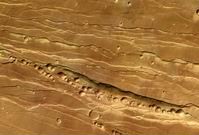 RGB Colour Image #1 |
On 29 December 2004 the High-Resolution Stereo Camera (HRSC) onboard the ESA spacecraft Mars Express obtained image data in orbit 1217 with a ground resolution of approximately 11.9 metres per pixel. The data were acquired in the region of Phlegethon Catena, at approximately 33.9° northern latitude and 253.1° eastern longitude.
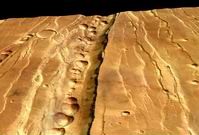 Perspective view #1 |
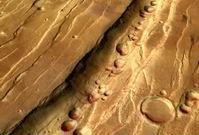 Grayscale Nadir Image |
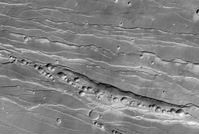 Grayscale Nadir Image |
The grabens may have formed as the result of stresses associated with the formation of Alba Patera, a volcano rising 3 to 4 km above the surrounding plains, or by the up to 10 km high Tharsis rise located to the south. It is unclear what process is responsible for the chain of depressions; collapse of the surface due to the removal of subsurface material is one possibility, while others suggest that tension cracks may have formed in the subsurface and caused subsequent collapse.
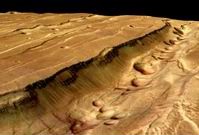 Perspective view #3 |
The colour scenes have been derived from the three HRSC-colour channels and the nadir channel. The perspective views have been calculated from the digital terrain model derived from the stereo channels. The anaglyph image was calculated from the nadir and one stereo channel. The black and white high resolution images were derived form the nadir channel which provides the highest detail of all channels.
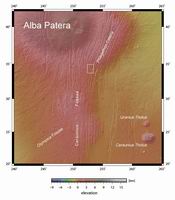 Context Map (MOLA) |
The High Resolution Stereo Camera (HRSC) experiment on the ESA Mars Express Mission is led by the Principal Investigator (PI) Prof. Dr. Gerhard Neukum who also designed the camera technically. The science team of the experiment consists of 40 Co-Investigators from 33 institutions and 10 nations. The camera was developed at the German Aerospace Center (DLR) under the leadership of the PI G. Neukum and built in cooperation with industrial partners (EADS Astrium, Lewicki Microelectronic GmbH and Jena-Optronik GmbH). The experiment on Mars Express is operated by the DLR Institute of Planetary Research, through ESA/ESOC. The systematic processing of the HRSC image data is carried out at DLR. The scenes shown here were created by the PI-group at the Institute for Geological Sciences of the Freie Universitaet Berlin in cooperation with the German Aerospace Center (DLR), Institute of Planetary Research, Berlin.
Download
hochaufgelöste Bilddaten / full resolution image data
| Context Map (MOLA): | TIF (744.8 KBs) / JPG (313.3 KBs) |
| Grayscale Nadir Image: | TIF (16.7 MBs) / JPG (10.4 MBs) |
| RGB Colour Image #1: | TIF (50.1 MBs) / JPG (12.8 MBs) |
| Perspective view #1: | TIF (50.1 MBs) / JPG (10.3 MBs) |
| Perspective view #2: | TIF (50.1 MBs) / JPG (10.3 MBs) |
| Perspective view #3: | TIF (50.1 MBs) / JPG (8.5 MBs) |

 Deutsch
Deutsch

